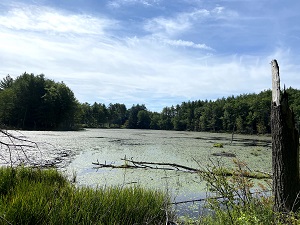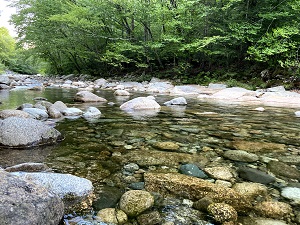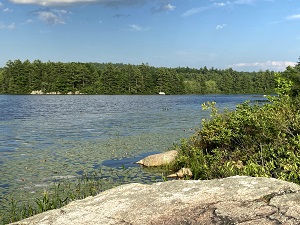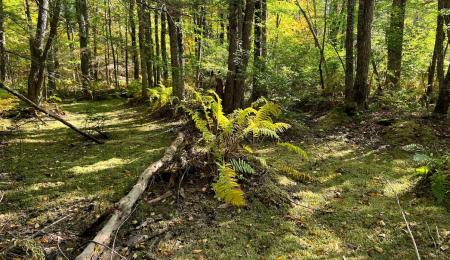Wetlands Mitigation
Protecting, enhancing and restoring wetlands and streams to compensate for unavoidable impacts.
Even after avoiding or minimizing impacts, some projects result in loss or degradation of wetlands and streams. The purpose of compensatory mitigation is long-term sustainability at watershed scales. Mitigation helps offset wetland and stream losses using land protection, restoration, and enhancement.
When mitigation is required
After avoidance and minimization to aquatic resources have been achieved through project location and design, mitigation is required for:
- Permanent impacts to freshwater wetlands of 10,000 square feet or more.
- Permanent impacts to tidal surface waters, tidal wetlands, the tidal buffer zone, or sand dunes, excluding several project-specific exemptions.
- Projects classified as major impacts to intermittent and perennial streams, including new channel and bank impacts more than 200 linear feet and tier-specific stream crossings.
- Pond construction with more than 20,000 square feet of impact in a wetland or surface water.
- Docks and new shoreline structures with 2,000 square feet or more total frontage on the waterbody.
- Any permanent impact to a Priority Resource Area, regardless of size, after additional avoidance and minimization measures have been taken.
If mitigation is needed to offset unavoidable impacts, permit applicants have two options available:
In-Lieu Fee (ILF) Payment: Permittees may make an In-Lieu Fee (ILF) payment to the Aquatic Resources Mitigation (ARM) Fund. NHDES will determine payment amount using a calculator published annually. Funds are awarded as grants to offset functions and values lost in the watershed.
Permittee-Responsible Mitigation: Permittees can restore, enhance or preserve land to compensate for project impacts. Permittees are responsible for the design, implementation, monitoring, and continued success of the mitigation project. Mitigation may occur at the same location as the impacts or at a different location within the same watershed. The applicant should consider priorities identified by the town’s conservation commission.
Mitigation Steps
 Impacts to wetlands and streams need to be avoided and minimized
Impacts to wetlands and streams need to be avoided and minimized
Because wetlands and streams provide important functions to wildlife, humans, and the overall environment, impacts to these resources need to be avoided and minimized to the greatest extent practicable.
 Explore Local Mitigation Opportunities
Explore Local Mitigation Opportunities
A permit applicant should consider local conservation projects prioritized by the town that may be used as permittee-responsible mitigation. The town Conservation Commission is responsible for creating a “Mitigation Priority List.”
 Make an In-Lieu Fee Payment
Make an In-Lieu Fee Payment
If there are no suitable, local mitigation projects, then the applicant can make a payment into the Aquatic Resource Mitigation Fund. NHDES will determine the amount of the payment required to compensate for wetland and stream impacts using the ARM calculator.
Types of Mitigation Projects
Various approaches can help compensate for lost functions from wetland and stream impacts. They can be used individually or in combination.
Restoration
These activities return a degraded wetland or stream to its natural condition.
- Examples include replacing "fill" with hydric plants, restoring natural hydrology by removing ditches and drains, and creating living shorelines in tidal areas where erosion and armoring have impacted marsh migration and tidal flushing.
- Examples of stream restoration include removing aquatic barriers such as dams and culverts to restore river environments, daylighting buried streams, removing hard armoring and using bioengineering to stabilize banks, improvements for fish and wildlife habitat, and reconnecting a floodplain.
Enhancement
Some physical, chemical, or biological characteristics of an aquatic resource can be modified to increase its functions. Enhancement is usually designed to target a specific improvement. For example:
- A perched culvert may be upgraded to an open-bottom arch to enhance fish passage and hydrology at a site.
- Riparian plantings in the buffer can improve water quality and wildlife habitat functions.
Upland Buffer Preservation
Permanent legal protection of a valuable wetland or stream and its upland buffer ensures that aquatic resources and their surrounding upland areas remain in natural, undeveloped condition in perpetuity. Protection is accomplished by placing the land under a conservation easement, which is held by a conservation organization, town, or state agency. Land preservation alone does not make up for lost wetland functions and values, but it does remove the threat of future loss and degradation.
Establishment (Creation)
"Man-made" wetlands involve excavating an upland area and achieving adequate hydrology to support hydric soils and vegetation. Based on past rates of success, high costs, and significant engineering needed, this is not a preferred method of mitigation.
Our ARM fund calculator has been updated to include a new field for calculating intermittent stream impacts at the appropriate rate. Because the US Army Corps of Engineers assesses stream credits differently for perennial and non-perennial stream impacts, this update ensures that the total ARM Fund payment for stream impacts accurately accounts for the sale of stream credits. Additionally, the calculator now includes fields for total stream and wetland credits to facilitate verification of credit sales. Please email des.arm@des.nh.gov with any questions or if you are in need of accommodation with this file.
Related Content
Aquatic Restoration Mapper
Use this interactive mapping tool to target potential mitigation projects to improve stream connectivity, restore important fish habitat and increase flood resiliency.
Wetlands Pre-Application Meetings
A pre-application meeting is required for all large projects with impacts to wetlands and streams that may require mitigation. Please send an email to rebekah.j.webb@des.nh.gov to schedule a meeting for your project. There are many benefits to having a pre-application meeting early in your project planning!
- An opportunity to meet with the regional wetland specialist to discuss your project and receive guidance on the information needed to complete your application.
- Establish good communication between state and federal agencies, and the local entities involved in your project.
- Discuss avoidance and minimization measures, and whether your project will require mitigation.
- Reduce rework by all parties – saving time and money!





